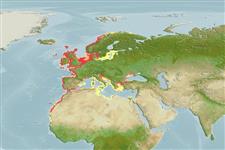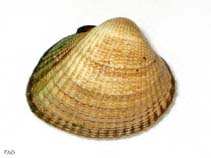Cerastoderma edule (Linnaeus, 1758)
Common edible cockle| Native range | All suitable habitat | Point map | Year 2050 |

|
| This map was computer-generated and has not yet been reviewed. |
| Cerastoderma edule AquaMaps Data sources: GBIF OBIS |
Classification / Names Common names | Synonyms | CoL | ITIS | WoRMS
Bivalvia | Cardiida | Cardiidae
Environment: milieu / climate zone / depth range / distribution range Ecology
Benthic; brackish; depth range 0 - 5 m (Ref. 125442). Subtropical, preferred 10°C (Ref. 107945); 71°N - 14°N, 17°W - 33°E (Ref. 107077)
Distribution Countries | FAO areas | Ecosystems | Occurrences | Introductions
Eastern Atlantic, the Mediterranean and Black Sea: from Portugal to Egypt, north to Norway and Russia then south to Senegal, including Mediterranean and Black Sea. Occurrence in Iran, Persian Gulf is questionable.
Length at first maturity / Size / Weight / Age
Maturity: Lm ? range ? - ? cm Max length : 5.6 cm SHL male/unsexed; (Ref. 101424); common length : 3.5 cm SHL male/unsexed; (Ref. 437); max. reported age: 7 years (Ref. 2823)
The Burry Inlet Cockle Fishery of this species has been certified by the Marine Stewardship Council (http://www.msc.org/) as well-managed and sustainable (http://www.msc.org/html/content_486.htm). Found in shallow coastal and estuary areas (Ref. 95774); in the subtidal zone (Ref. 96507). Inhabits the seagrass meadows Zostera noltii and Cymodocea nodosa in sand flats (Ref. 106872). Also found on intertidal muddy sand flat. Infaunal (Ref. 106873). A deposit (Ref. 96459), and suspension feeder (Refs. 96498, 106872, 106873) that is a sessile-burrower (Ref. 96498). Feeds on microphytobenthos and particulate organic matter (Ref. 106873).
Life cycle and mating behavior Maturity | Reproduction | Spawning | Eggs | Fecundity | Larvae
Members of the class Bivalvia are mostly gonochoric, some are protandric hermaphrodites. Life cycle: Embryos develop into free-swimming trocophore larvae, succeeded by the bivalve veliger, resembling a miniature clam.
Main reference
References | Coordinator | Collaborators
Fischer, W., G. Bianchi and W.B. Scott (eds.). 1981. (Ref. 437)
IUCN Red List Status (Ref. 130435)
CITES status (Ref. 108899)
Not Evaluated
CMS (Ref. 116361)
Not Evaluated
Threat to humans
Human uses
Fisheries: commercial
FAO - Aquaculture: production; Fisheries: landings, species profile | FishSource | Sea Around Us
Tools
More information
Internet sources
BHL | BOLD Systems | CISTI | DiscoverLife | FAO(Fisheries: species profile; publication : search) | Fishipedia | GenBank (genome, nucleotide) | GloBI | Gomexsi | Google Books | Google Scholar | Google | PubMed | Tree of Life | Wikipedia (Go, Search) | Zoological Record
Estimates based on models
Preferred temperature
(Ref. 115969): 7.6 - 13.7, mean 10.4 (based on 742 cells).
Resilience
(Ref. 69278):
High, minimum population doubling time less than 15 months (K=0.46-0.66; tmax=7).
Prior r = 0.49, 95% CL = 0.33 - 0.74, Based on 1 data-limited stock assessment.
Nutrients: Calcium = 149 [71, 228] mg/100g; Iron = 8.53 [1.95, 15.11] mg/100g; Protein = 9.88 [8.64, 11.12] %; Omega3 = 0.313 [0.202, 0.423] g/100g; Selenium = 61 [50, 72] μg/100g; VitaminA = 0 μg/100g; Zinc = 2.04 [0.56, 3.51] mg/100g (wet weight).



